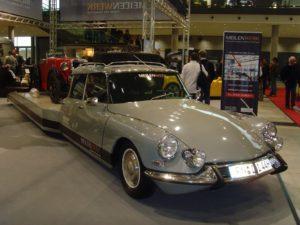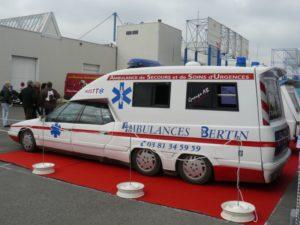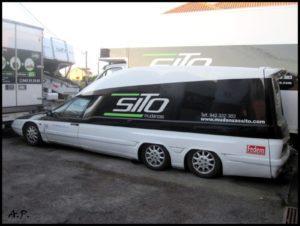Or a Citroën CX. Even the XM got mythical dimensions in the workshop in Villeneuve-le-Roi.
Strange beauty
Pierre Tissier was a man with two right hands and a passion for cars. However, this much more common combination did not necessarily lead to particularly successful or beautiful creations in the past. On the contrary. In the case of this former machine bench worker. Although his early creations on the basis of the legendary DS were aesthetically quite surprising, the combination of gendered form and added functionality was a very special and therefore of a strange beauty. And successful.
Logistics
Tissier started a small car company in Villeneuve-le-Roi in the early years of 60 and focused mainly on the French Panhard brand. The otherwise so chauvinistic local population apparently was less charmed than himself, because the majority of his used Panhards sold Pierre Tissier to his southern neighbors. The slow logistics of a lorry that drove up and down with a snail's pace to Spain did not seem to be a satisfactory solution for the train-traveler. After the umpteenth time-consuming episode of a Panhard, he came up with the bright idea of a comfortable one Citroën DS can be converted into a fast car transporter. Eureka. The train wasn't that bad yet.
Patent
Not at all the DS: its front-wheel drive and especially the hydropneumatic suspension made the Déesse an extremely stable and comfortable platform. Very flat even. The French beauty was sawn off without batting an eyelid behind the front doors and a three-axle platform was welded against it. Like this. The beauty of a DS was halved, at least. Inversely, the effectiveness of the ailing goddess was increased by at least 50%. It was something. At least a lot of wheels. And many more views. So much so that Tissier applied for a patent in 1972 and started building this multifunctional pike on request and in small series. Because besides cars, it turned out that much more could be transported or built up with them: from complicated camera rigs to small helicopters. Pierre Tissier's brainchild imperturbably carried all kinds of things around. The applications were very diverse and so were Tissier's ideas. He also developed a closed version of the unique centipede, the fourgon. This van was also built on the basis of a DS sedan, but now with two rear axles with 13-inch wheels. The beast had become a beauty again.
Hollander
This version was clearly appreciated by Hollander SA France, a courier company that mainly distributed newspapers throughout the northern part of Europe. They were particularly charmed by this attractive workhorse and immediately ordered a dozen. The 6,5 meter long Citroëns departed from Paris at night and brought a beautiful load of newspapers to various European cities in a stunningly fast pace thanks to their load capacity of 2000 kg. That brought the total to a small 4000 kg in weight for this fast-paced orderer and because of course it was impossible to slow down with the latest news, it took a lot of fuel to deliver the newspapers on time. The fourgons were therefore equipped with three fuel tanks as standard, with a total capacity of 280 liters. That was up again in the morning.
Successor
Constructor Tissier remained successful, even becoming a one-off exclusive Citroën SM converted into a car transporter with four hydropneumatic rear axles, and from 1977 the CX was also available as the successor to the DS. In various short or long versions as an orderer, or as an open transporter with six or eight wheels. And just like their predecessors, these variants could be supplied with single or double cabs. Hollander SA turned out to be a loyal customer and ordered a fleet of CXs in Villeneuve-le-Roi. In 1981, Tissier presented the CX 14, a luxury passenger version of the long van, in which 14 lucky mates found a comfortable place. Equally unique was the CX Penthouse, a motorhome version with a raised roof that was unveiled a year earlier. For employees who were not yet on holiday, in addition to the "normal" freight versions, there were also the ambulances and special versions for refrigerated transport. Everything was possible if there were at least three axes underneath. In the meantime a bit of his trademark, or maybe Pierre Tissier had bought a lot of wheels.
End
That stock apparently steadily declined, because successor XM was also converted by the ingenious French into a longer version with only a single rear axle, the limousine. Of course, the well-known order and ambulance versions with multiple rear axles of this model were also available. After the XM, there was still experimentation with the Jumpy as a long-term buyer or ambulance. But the larger car manufacturers themselves also started to deliver longer and heavier versions of their own models and the demand for conversion fell sharply. Pierre Tissier closed the doors of his unique company in 2007, and died in 2010. Hopefully he was driven quickly and comfortably to his final resting place, on at least three axes.









I think the white cx is a Loadrunner from CX Basis and not a Tissier. The rear wheels are too close together.